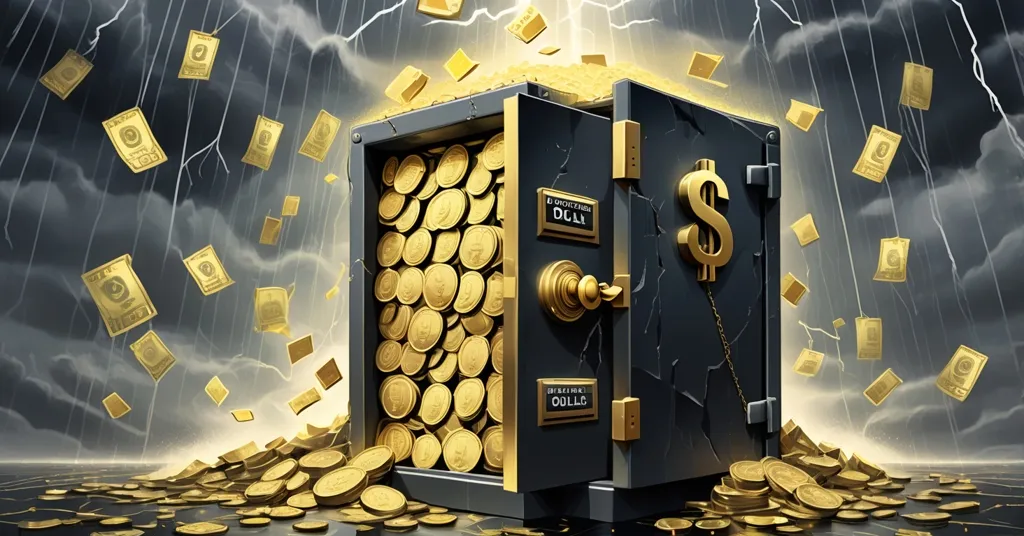Tether’s $14.6B Loan Risk Sparks Alarm as Stablecoins Gain TradFi Traction

Tether’s Loan Controversy Explodes While Stablecoins Storm Mainstream Finance
Stablecoins are reshaping the financial frontier, acting as the critical bridge between blockchain innovation and traditional money systems. Yet, beneath the hype, cracks are showing. Tether’s risky loan surge raises alarms, while heavyweights like Western Union and Canada push stablecoin adoption into the spotlight. Let’s cut through the noise and dissect the promise, peril, and power plays driving this seismic shift.
- Tether’s Risky Gamble: Secured loans balloon to $14.6 billion, outstripping its $6.8 billion equity, defying prior pledges to cut them.
- TradFi’s Big Bet: Western Union plans a Solana-based stablecoin for 2026, as Mastercard and Coinbase chase billion-dollar acquisitions.
- Canada’s Guardrails: New legislation regulates fiat-backed stablecoins, aiming for safety and innovation in the global race for digital money.
Tether Controversy: A $14.6 Billion Loan Time Bomb?
Tether (USDT), the undisputed titan of stablecoins, boasts a mammoth market cap of $183.3 billion as of October 4, 2025, climbing from $174.4 billion in mere days. Its reserves stand at $181.2 billion, leaving a surplus—or equity—of $6.8 billion, down slightly from $7.1 billion in December 2024. For the uninitiated, a stablecoin like USDT is a digital token pegged to a fiat currency (here, the U.S. dollar) at a 1:1 ratio, designed to offer stability in the wild west of crypto trading. Tether’s dominance makes it the lifeblood of liquidity on many exchanges—the fuel that keeps buying and selling humming without wild price swings. But peel back the curtain, and the picture gets murky fast.
In Q3 2025, Tether’s “secured loans” soared to $14.6 billion, up from $10.1 billion the prior quarter. That’s more than double its equity, a glaring mismatch. Think of these loans as lending cash to a buddy, with a promise they’ve got something valuable as backup if they can’t pay. The rub? We don’t know who these buddies are—often rumored to be affiliates like sister exchange Bitfinex—or if their collateral is worth a damn. Tether vowed years ago to phase out these loans, yet here we are, with numbers climbing. Worse, there’s no full, independent audit of their reserves, just “attestations” from BDO Italia—more like a quick report card than a deep dive into every corner of their finances. Hidden risks could be lurking, and in crypto, blind trust is a fool’s game. For more on this escalating issue, check out the detailed report on Tether’s controversial loan surge and Canada’s stablecoin developments.
Then there’s the cash-out conundrum. Tether dished out $10.4 billion in dividends to shareholders in the first nine months of 2025, edging past their reported profits of $10.1 billion. Are they milking the cow dry while systemic risks pile up? Their balance sheet shows some safe plays—$112.4 billion in U.S. Treasury bills, up from $105.5 billion in Q2—but also speculative bets like $9.85 billion in Bitcoin (a 10% increase, including a $1 billion purchase of 8,889 BTC from Bitfinex on September 30) and $13 billion in gold, up nearly 50%. CEO Paolo Ardoino shot down rumors of dumping BTC for gold, tweeting on September 7, 2025:
“Tether didn’t sell any Bitcoin.”
Okay, fair play. But with ownership tightly held—founder Giancarlo Devasini controls over 50% of voting interest, Ardoino around 20%, and former CEO Jean-Louis van der Velde at 10-15%—and plans to raise up to $20 billion by offloading just 3% of the company, the opacity stinks. Let’s not forget history: Tether settled with the New York Attorney General in 2019 for $18.5 million over claims they misrepresented reserves. Today’s loan explosion just resurrects those old ghosts. If USDT falters, the shockwaves could cripple exchanges and traders alike. To play devil’s advocate, Tether has survived depegging scares and legal battles while holding its 1:1 peg. Maybe their collateral is rock-solid, even if we’re in the dark. Still, this reckless tightrope walk keeps us Bitcoin maxis on edge—BTC’s transparency is why it remains the true bastion of financial sovereignty.
Western Union’s Blockchain Bet: A Solana Stablecoin by 2026
While Tether wrestles with its demons, legacy financial giants are storming the gates of crypto, seeing stablecoins as a way to reinvent money movement. Western Union, a remittance titan with over a century of history, is set to launch its U.S. Dollar Payment Token (USDPT) on the Solana blockchain in the first half of 2026, with issuance managed by Anchorage Digital. They’re also building a Digital Asset Network for crypto off-ramps and have trademarked WUUSD. CEO Devin McGranahan laid out the stakes bluntly:
“USDPT will allow us to own the economics linked to stablecoins.”
This isn’t a casual experiment. Western Union is gunning to slash costs and speed up cross-border transfers using blockchain’s efficiency. Solana, for those new to the game, is a layer-1 blockchain rivaling Ethereum, processing thousands of transactions per second at pennies per pop. That’s a dream for payment firms, but Solana’s not flawless—past outages, like a 17-hour downtime in 2021, raise questions about reliability. Could a remittance giant banking on uptime face hiccups? Might Western Union hedge with other chains like Ethereum or Polygon if Solana stumbles? Either way, this move signals a future where TradFi doesn’t just flirt with crypto—it aims to rule it.
TradFi’s Stablecoin Power Grab: Mastercard and Coinbase Go Shopping
The stablecoin race isn’t just about new tokens; it’s about owning the plumbing. Mastercard is in late-stage talks to acquire Zerohash, a Chicago-based firm specializing in stablecoin and blockchain infrastructure, for $1.5 to $2 billion, up from its recent $1 billion valuation. Meanwhile, Coinbase is eyeing BVNK, a UK electronic money institution focused on stablecoin payments, for roughly $2 billion after outbidding Mastercard. These aren’t small-time deals. Zerohash and BVNK are the hidden machinery powering digital dollar flows—think of them as the backstage tech making transactions seamless.
For Mastercard, snagging Zerohash is a bid to weave stablecoins into every swipe and tap globally, challenging Visa’s recent crypto card ventures. Coinbase’s play for BVNK doubles down on stablecoin payments as exchanges brace for slimmer margins on volatile assets like BTC or ETH. This digital land grab shows both TradFi and crypto natives betting hard on stablecoins as the backbone of future finance. It’s not hard to see why: unlike Bitcoin’s wild price swings, stablecoins offer predictability, making them ideal for everyday payments and corporate adoption. But will this centralization of infrastructure clash with the decentralized ethos we champion? That’s the million-dollar—or billion-dollar—question.
Canada Sets the Regulatory Bar for Stablecoin Safety
Up north, Canada is carving a path for stablecoin legitimacy with a regulatory framework unveiled in its federal budget on November 4, 2025. The legislation targets fiat-backed stablecoins, mandating adequate reserves, robust risk management, and consumer data protections. The Bank of Canada is backing this with C$10 million (about US$7 million) over two years to roll it out. Coinbase Canada Director Lucas Matheson captured the moment on Twitter:
“Canada has joined the global conversation on the future of money… the real work starts now.”
This isn’t red tape for kicks. By setting clear rules, Canada wants to nurture innovation while dodging disasters like reserve mismanagement seen elsewhere. For clarity, a fiat-backed stablecoin is pegged to a real-world currency like the Canadian dollar, ideally backed by equivalent cash or assets to maintain its value. Local players are already jumping in—Tetra Digital Group in Alberta raised C$10 million to launch a Canadian stablecoin by early 2026. Compared to the EU’s MiCA framework, which enforces strict reserve audits since 2024, or the U.S.’s messy state-vs.-federal tug-of-war, Canada’s middle-ground approach—innovation with guardrails—could inspire hesitant nations. It’s a nod to effective accelerationism (e/acc), pushing rapid progress without ignoring the potholes. Could this balance be the blueprint for global stablecoin policy? We’re watching closely.
Circle’s Cultural Tightrope: Stablecoins in Real-World Messes
Stablecoin issuers aren’t just coding tech—they’re navigating societal minefields. Circle, behind USDC (the second-largest stablecoin), faced backlash from U.S. firearm advocates over initial restrictions on gun-related transactions. Bowing to pressure, they updated their terms to allow lawful firearm purchases, as protected under the Second Amendment. Their revised stance, reported by the National Shooting Sports Foundation, states:
“We have clarified our Terms to reflect that USDC may be used for the lawful purchase and sale of firearms, as protected under the Second Amendment.”
This isn’t a trivial PR tweak. It spotlights the gatekeeper power stablecoin issuers wield, deciding who transacts and for what. Such centralized control grates against Bitcoin’s censorship-resistant core, raising doubts about whether stablecoins can ever fully embrace decentralized values. It’s a stark reminder that blockchain isn’t just about tech—it’s about people, politics, and messy integration into daily life. For us Bitcoin purists, it’s another reason to question if stablecoins, despite their utility, stray too far from the cypherpunk roots we hold dear.
Stablecoins at a Crossroads: Trust or Bust?
Stablecoins are stealing the spotlight in mainstream finance, offering stability and practicality that speculative assets like Bitcoin can’t match for payments. Tether reigns supreme, but its $14.6 billion loan gamble is a screaming red flag—if it trips, the fallout could torch crypto’s fragile ecosystem. Meanwhile, Western Union’s Solana pivot, Mastercard and Coinbase’s infrastructure grabs, and Canada’s regulatory clarity signal a tidal wave of adoption. Yet, shadows loom: Tether’s murky transparency, Circle’s centralized policy whims, and TradFi’s power plays hint at risks of over-centralization.
We’re all for disrupting the status quo and accelerating innovation, but not by sweeping systemic flaws under the rug. Stablecoins could redefine money, but only if trust and accountability catch up to the hype. Will they become the reliable spine of digital finance, or will unchecked gambles and centralized control derail their promise? Time—and ruthless scrutiny—will tell. For now, Bitcoin remains our north star of freedom and privacy, even as stablecoins carve their niche in this financial revolution.
Key Questions and Takeaways on Stablecoins’ Rise
- Could Tether’s loan surge trigger a crypto market crisis?
Absolutely possible—$14.6 billion in secured loans dwarfing $6.8 billion in equity, with no full audit of collateral or affiliates, means a misstep could tank USDT’s peg and hammer exchanges reliant on its liquidity. - Why are financial giants like Western Union diving into stablecoins?
They’re chasing efficiency—stablecoins on blockchains like Solana slash costs and speed up global transfers, letting firms dominate digital payments and outpace legacy systems. - What does Canada’s stablecoin regulation signal for the industry?
It’s a push for legitimacy, mandating reserves and protections to balance innovation with safety, potentially inspiring a global standard for stablecoin oversight amid rising adoption. - Are stablecoins eclipsing Bitcoin in mainstream traction?
Right now, yes—their predictability suits TradFi and payments, as seen with Western Union and Canada’s moves, while Bitcoin stays a speculative, ideological asset for many. - Can stablecoins align with Bitcoin’s decentralized ethos?
It’s a long shot—Circle’s policy shifts and Tether’s opacity highlight centralized control, clashing with BTC’s censorship-resistant freedom, suggesting an uneasy coexistence at best.



